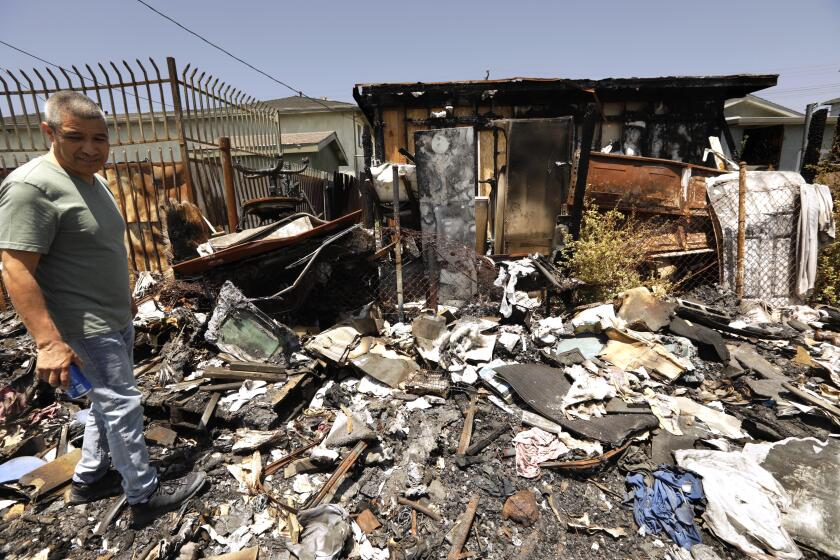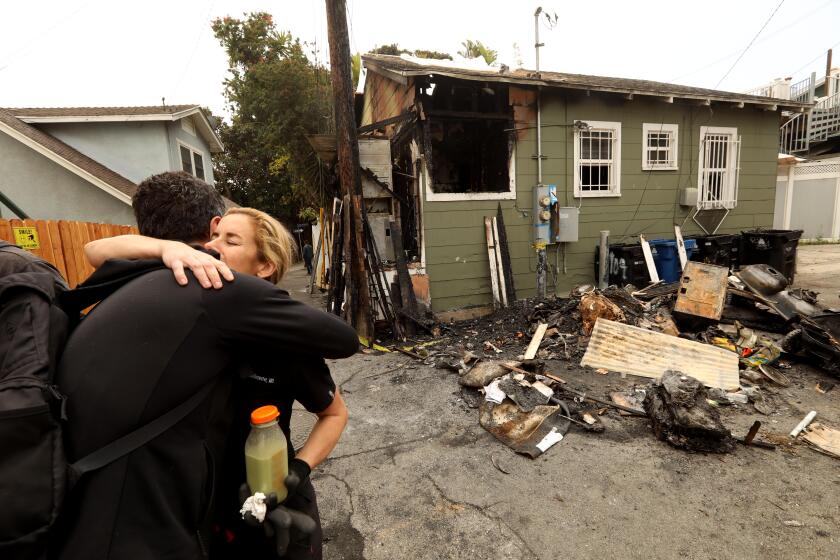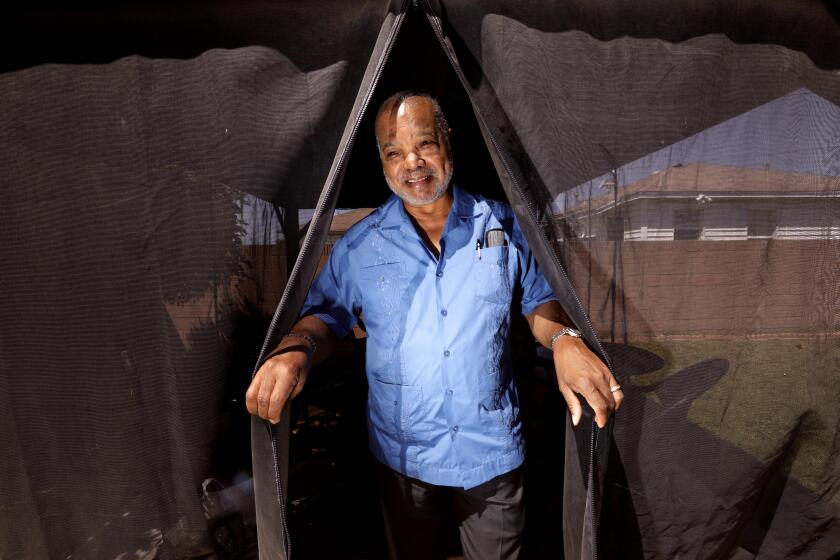
- Share via
The manhole cover was pushed aside, and the opening in the abandoned street revealed the scorched remains of a bed 6 feet below.
Crouched beside the hole, Juan Luis Gonzalez-Castillo described his brief habitation in the storm drain.
“One day I walked into this property and found a drain,” he said. “I opened it and it was dry. I cleaned a spider web. So I started living here.”
The manhole he called home is on a street the city of Los Angeles built on a field that was meant to revitalize a community bled of its economic base and traumatized by the 1992 riots. The road was the first step in a strategy to bring hundreds of high-tech jobs to Watts with the first industrial development in the area since the 1970s.

Instead, nearly three decades of ineffectual city initiatives have left nothing more than a 10-acre vacant lot useful only to Gonzalez-Castillo and the shanty dwellers he thinks of as neighbors.
There have been at least five proposals to build facilities for furniture construction, food processing and light steel manufacturing among other labor-intensive industries. Something killed them all — lack of financing, burdensome city demands and better offers elsewhere. Only weeds, trash and despair persist.
Read more coverage
A fire at homeless camp spread and burned his house down in Watts. He and his neighbors fear that it will happen again, as city does little to help.
Now, as the city struggles with a severe housing shortage and a growing homelessness crisis, the lot, known as the Lanzit property after the street on its south side, is getting attention as a potential site for homeless housing.
Calling the city out for “a lack of leadership, accountability that has been lacking, of deficient priorities and siloed departments,” City Controller Ron Galperin used the property as a backdrop for a news conference earlier this year urging the use of city-owned land for interim housing, tiny homes, safe camping or trailers.

“The property behind me can and should be used to help get people off of our streets and into shelter right away,” Galperin said. “What we really need to do is to cut through all of the bureaucracy to actually save lives and get people off the street.”
Though the idea is winning support in some quarters, including an urban planning professor at USC who used it as the subject of a class project, others say the community has already absorbed too much homeless housing and are adamant that it deserves the jobs that an industrial development would bring.
“More affordable housing at this location would cost this part of the city its last opportunity to have a job-generating industry,” City Councilman Marqueece Harris-Dawson said in an interview. “This is a part of the city that the economy has aggressively abandoned and, frankly, practiced apartheid on.”
Parts of South L.A., battered in the ’92 uprising, have been frozen in time. Now property prices are soaring and change is coming. Who will benefit?
For nearby residents and business owners, the hope of any benefit from the land has long since died. To them, the Lanzit property is simply a drag on the industriousness of a community where vacant lots are turned into vegetable gardens and men labor with pride at jobs such as making cabinets and manufacturing pool-light housings.
The property has become the focus of a spontaneous neighborhood watch. When two strangers were spotted on it, Germán Manrique Magaña, the unofficial neighborhood ombudsman, drove up in a black pickup.
After learning the interlopers were reporters, Magaña handed over his cellphone to show a YouTube video he made of a community cleanup earlier this year. Volunteers in fluorescent T-shirts piled trash into 4-foot-high furrows down the center of the road for city trucks to haul away.

“I used to say, ‘Don’t get involved. Let it go, let it go.’ But this has gotten out of hand,” he said.
Magaña then led the reporters on a walking tour of businesses on 108th Street — where he has a shop that services hydraulic equipment — and homes bordering the property on the west.
Reaction to tiny homes or trailers was generally negative.
A developer working to preserve affordable rentals in South L.A. and build housing for homeless people has won praise from the likes of Oprah Winfrey and Mayor Eric Garcetti, who see his work as an important step in dealing with the city’s housing crisis. But the entrepreneur’s efforts are also facing criticism from tenant advocates. A look inside SoLa Impact.
“I don’t think it’s a good idea, man,” a grit-covered Luis Quiñones said, taking a break from his job polishing wheels.
“Those people got mental illness. They got drug problems,” he said. “When they’re on their thing they don’t respect other people’s property, you know. We’ve seen them trying to come in here banging on the door. You park your car, they try to steal your catalytic converter, break your windows.”
“I have children here, and I don’t feel safe here because there’s all these strangers,” said Erica Flores, who lives with her mother and two children across the street from the property.

The 8-foot fence that secures the property was broken when a car rammed it at the dead end of 109th Street. As Flores spoke, the iron bars made a metallic screech as a woman pushed a baby stroller through the opening. She was making her second loop through the neighborhood that day, speaking nonstop and unintelligibly.
“Two years having these strangers, car theft, fights,” Flores said. “There’s drug stuff.”
The fence was repaired but soon breached again by people who use the opening to take stolen cars onto the property.
Jamiah Hargins wants microfarms to feed Los Angeles one frontyard at a time.
“People come and bring cars in broad daylight,” Flores said. “They come and cut off parts of the cars. We tell them to leave. They’re like, ‘We’ll leave right now when our work is done.’ ”
On the other side of the property, Magaña stood at the edge of a patch of burned weeds, speaking through the fence with Frank Carrasco, maintenance manager at Cardinal CT glass tempering.
“We have video that shows they intentionally light the fires,” Carrasco said. “The majority of them are on drugs. They don’t know what they are doing.”
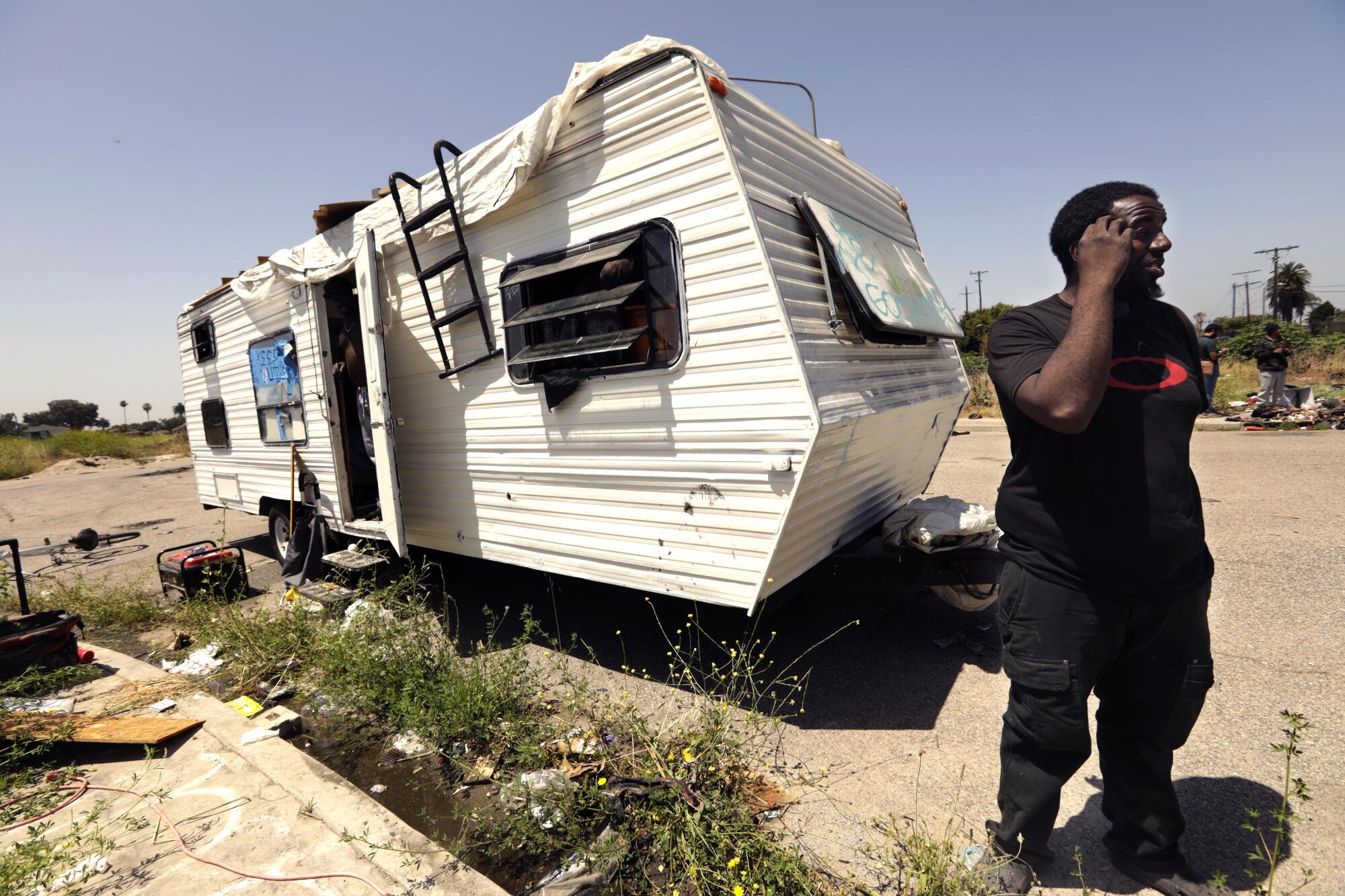
It’s not evident how many people live on the field. To the east of the entrance on Clovis Avenue, just south of 108th Street, two or three wooden structures evince entrenched occupation. To the west, several tarp shanties are less permanent. The owner of a trailer home parked on the street, Asa Grissett, said he had heard the field was a safe parking site, so he bought the trailer at an auction and got a friend to drive it there.
A man whose place of habitation was unclear showed up with a bicycle and a gallon of black paint he had found and began painting the window frames on the trailer, using a rag as a brush.
Gonzalez-Castillo, the manhole dweller, comes and goes. He said he’s lived a short time in an Exodus Recovery home and other places. He checked himself into Martin Luther King Jr., Community Hospital after he slashed his wrists with a piece of broken glass.
In the three years since the Los Angeles Fire Department began tracking them, fires related to homeless camps have more than doubled.
“It wasn’t, ‘Oh, I want to end my life,’” he said. “It was more the voices telling me, ‘Do this now.’ I was still alive so I walked to ER.”
He was sent from there to a home in the Valley where he stayed a few weeks and got medication.
“I don’t have a Social,” he said. “They discharged me because my insurance didn’t cover the cost.”
“Do you use anything else to alleviate your pain?” Magaña asked.
“Meth and weed,” Gonzalez-Castillo said. “It all depends. It’s a different type of mellow.”
In Magaña‘s view, the people who live on the property are the symptom, not the problem — which he sees as bureaucratic malaise.

The Salvadoran native said he once used a crane from his shop to block the entrance to the property with a concrete freeway barrier left behind by Caltrans, the previous owner. He said the fire department pushed it aside and cut the locks that he and others put on the chain-link gates at the entrance.
“I’m a nobody,” Magaña said. “Nothing gets done. We’ll work on the barricade again. But how long can we be the dam holding it up. How long?”
The city bought the land for $3.2 million in 1994, put in a road and utilities and then sought proposals.
The first plan, for light manufacturing, a child-care center and job-training programs, fell victim to City Hall intrigue when a national trash-hauling firm that agreed to finance part of the project allegedly backed out after winning the contracts it was seeking.
A former Motown singer-songwriter faced a dilemma as subsidized housing for unhoused people and those with mental illness was built in his neighborhood. Follow NIMBYism or the Bible.
The developer, the nonprofit Lynwood-based Economic Resources Corp., couldn’t put its financing back together. After five years, the city withdrew exclusive development rights in 2000 and sought a new developer.
Seeing 10 acres of vacant land, Craig Furniss’ first thought was, “This is unbelievable. There must be something wrong.”
Finding nothing demonstrably wrong, Furniss and his partner, fresh from success in building the Alameda Trade Center produce market in downtown, took a chance. Partnering with the Watts Labor Community Action Committee, a jobs and social services nonprofit born out of the 1965 Watts riots, they made a winning bid in 2004 to build food-processing facilities.
Five years later, worn down by a plethora of bureaucratic setbacks, they gave up, Furniss said.
The neighborhood never got behind the plan, he said, and the city kept adding demands.
“They just kept layering these things,” he added.

Among those, he recalled, were building setbacks, job-creation targets with penalties for falling short and pre-approval of property transfers.
Then a change in mayoral administrations brought a new planning director and a new requirement: The city wanted a percentage of any profits.
“It didn’t seem like the city was moving in a direction that was trying to help us in the end,” Furniss said. “We vowed never to do business in the city of Los Angeles again.”
The Watts Labor Community Action Committee never lost interest. It already owned all types of properties in Watts, including a homeless services access center around the corner from the Lanzit property entrance.
Responding to a city call for proposals in 2010, it put together a development plan to build facilities for freight-forwarding, food-processing and community service organizations. A different bidder was chosen, but the developer unexpectedly died.
The city issued another request for proposals in 2017 and selected a Tennessee company to build a facility that would manufacture light-gauge steel for local construction.
But Jobsite Steel Manufacturing got better offers from San Bernardino and then Nevada, which offered it 50 acres along a highway and no taxes for the first five years, Harris-Dawson said. “So, Jobsite Steel is in Nevada.”
Deepak Bahl, program director for the USC Center for Economic Development, said he thinks the city should shift its priority to affordable housing.
Los Angeles has created an ambitious plan to build more housing, especially affordable housing, throughout the city.
Bahl used the Lanzit property as a case study, asking urban planning students to evaluate its best use. Most settled on a combination of residential and commercial, he said.
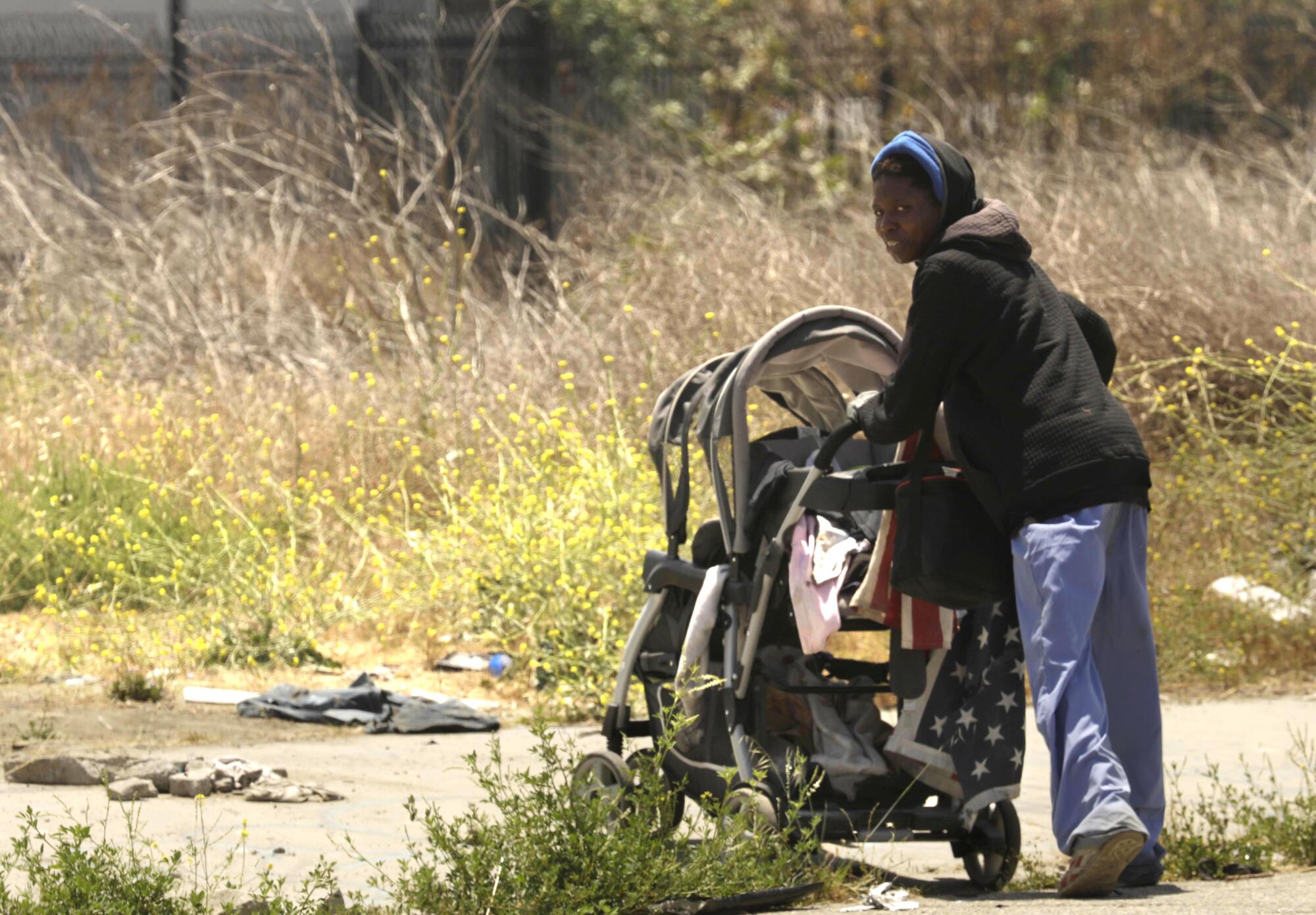
“I think given the crisis we are facing both on affordable housing and the homelessness that we are seeing and visible signs of it, it would be prudent for the city to repurpose the site for such uses,” Bahl said.
In 2019, the city took another tentative step, issuing a request for “expressions of interest” (EOI) that opened the door to “a combination of uses” not limited to manufacturing.
“Consideration will also be given to conceptual ideas that speak to local identity, the Watts community in particular, as a sports, cultural, entertainment, art and creative center that would further synergize existing local assets,” it said.
But two of the proposals were conventional industrial parks. The principals of the companies said they have received no response from the city. The third, a mixed-use development combining cannabis production and distribution with affordable housing, has since been withdrawn.
The city’s Economic and Workforce Development Department, which controls the Lanzit property, attributed the delay to changing staff priorities due to the pandemic.
“There are currently ongoing discussions with multiple departments on the use of this site, which will be informed by these EOI responses and assessment of current city priorities,” it said in a statement.
Harris-Dawson said he is hopeful that one of the responses will be successful.
“It’s one of those things where you keep knocking on the door, and one day someone’s going to answer, and it’ll be the right answer,” he said.
Compared to the glacial pace of bureaucracy, life on the Lanzit property is in constant flux. In the weeks since Galperin made his plea, a fire blackened about an acre, and the trailer home that appeared on the end of the road a few weeks ago has been hauled away.
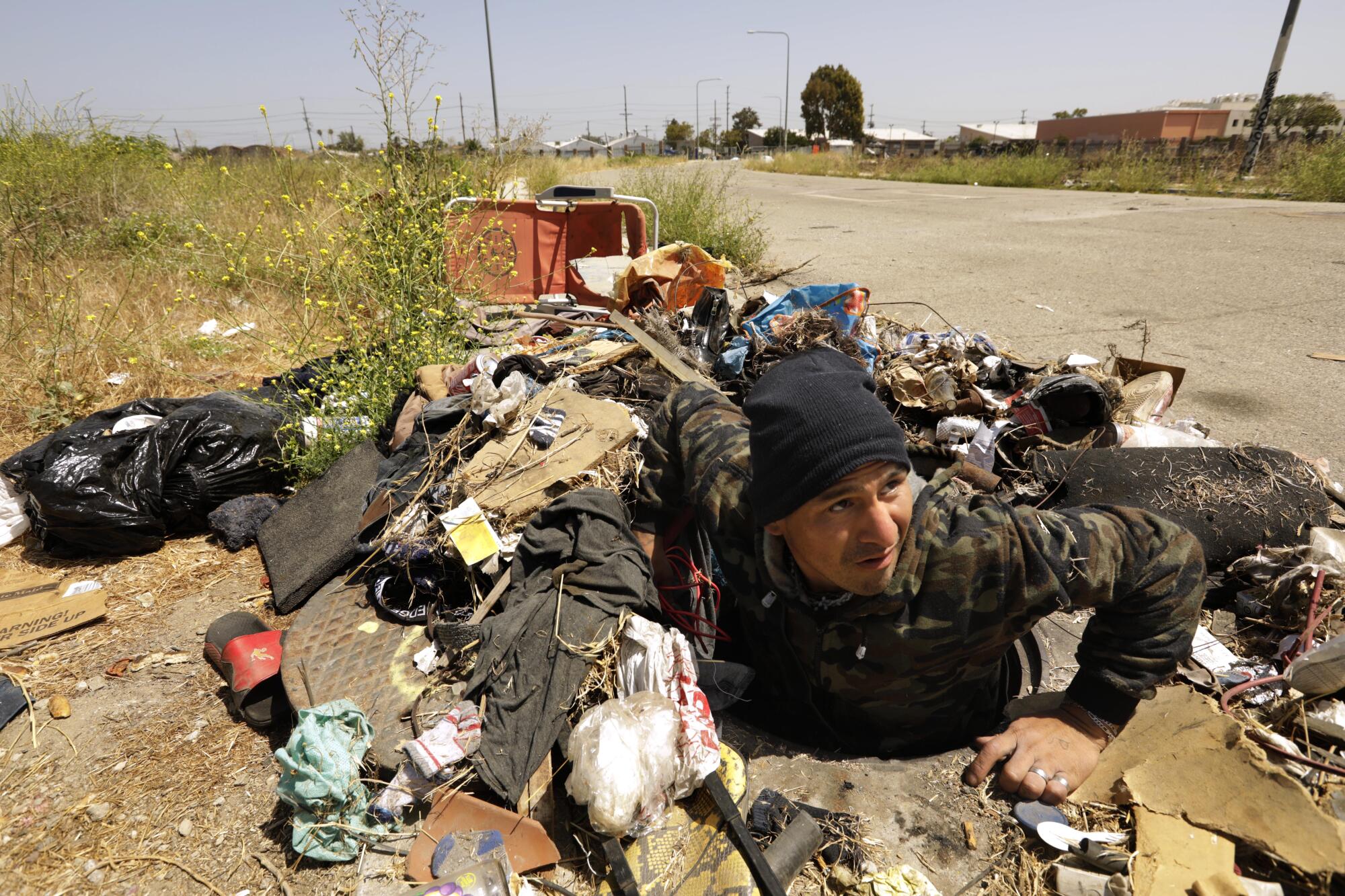
Gonzalez-Castillo no longer lives under the storm drain. It became a chamber of soot after the candle he used for a night light caught his bedding on fire.
“When I am out, I sleep wherever I find myself tired,” he said.
One day he took a leisurely bath after someone dragged a commercial water tank with its top cut off down the street and filled it from a hose attached to a hydrant. The makeshift tub is now gone.
“I go to the community center to shower and get soup,” Gonzalez-Castillo said. “There is a trash bin behind a restaurant here. I go and pick up the pizzas they throw away. There is nothing to be embarrassed about. It is better than stealing.”
More to Read
Sign up for Essential California
The most important California stories and recommendations in your inbox every morning.
You may occasionally receive promotional content from the Los Angeles Times.
